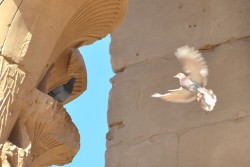
I made the dastardly decision to travel through southern Egypt on an organized tour. Well, maybe more naive than dastardly. In any case I don’t particularly recommend booking a tour of Egypt when you visit the land of the Pharaohs.
I do, however, absolutely recommend visiting the southern part of the country, if only to sail up the Nile river on a traditional felucca boat. Southern Egypt is calm, sparsely populated and culturally separate from much of the rest of the country, as I hope these photos convey.

Whether you travel independent or on an organized tour, your first stop in southern Egypt will almost certainly be the city of Aswan. Located approximately 200 miles from the Sudanese border, Aswan is at the center of what was once Nubia, a kingdom of black Africans that was repeatedly absorbed into the pharaonic kingdoms of Egypt, only to gain independence and then be re-conquered. These days, the city is a mix of indigenous Nubian and the Arabs that currently inhabit most of the rest of Egypt — and Islam is as strong in southern Egypt as anywhere else in the country. As you can see, the revolutionary fervor born in Cairo has also made its way down to Aswan.

One of the central tourist attraction of Aswan is the Aswan High Dam and the resultant Lake Nasser. I say “resultant” because Lake Nasser didn’t exist prior to the construction of the Dam, which was completed in 1971. At that point, collected waters from Nile flooded previously barren swaths of desert, forming a large, manmade lake that stretches into Sudan. Although the dam itself is nothing to write home about, the vastness of the lake is overwhelming.

Aswan has been perhaps the hardest hit of all Egypt’s cities by the tourist drought that has arisen in the wake of this year’s revolutions. Walking through Aswan’s Old Bazaar at night, I was greeted by many a shopkeeper desperate enough to part with his items for literally next to nothing. As shown above, the majority of shoppers were local people at the time. Even if you don’t take one of these merchants up on his too-good-to-pass-up deal, a trip through the Aswan Bazaar is definitely worth your while.

Abu Simbel temple is probably the most famous tourist attraction in the vicinity of Aswan, located about three hours south near the Sudanese border. It’s only possible to reach Abu Simbel, which were constructed around 1264 B.C. by Ramesses II, by a convoy of tourist vans that leaves Aswan at the agonizing hour of 3 a.m. Surrounded by the waters of Lake Nasser, Abu Simbel is definitely one of the coolest places I’ve ever visited, although the organized nature of tours there (even if you aren’t traveling southern Egypt on an organized tour) makes the experience a bit rushed.

If you take one piece of advice from all my Egypt content, it’s that you absolutely must spend at least one night aboard a traditional felucca sailboat when you visit southern Egypt. After departing Aswan, you’ll spend an afternoon and evening (and the very early part of the next morning) out on the water, before docking about 100 km south of Luxor, the next stop on the southern Egypt tourist trail.

En route to Luxor you stop at Esna Temple, built in the Greco-Roman period of Egyptian history during the third century B.C. The temple complex is massive in extent, centered around The Temple of Khnum, the God of the source of the Nile River. Since you’ll pass near the Temple of Esna on your way north through Egypt anyway, I highly recommend making at least a brief stop there.

Luxor itself isn’t anything particularly special, a mid-sized city that has grown almost entirely as a result of the Egyptian tourist industry. Located about 300 km north of Aswan, Luxor is closer in ethnic and cultural composition to the rest of Egypt — you can see four minarets in this picture alone. As was the case with me, you’ll probably do little more than sleep and eat dinner in Luxor or perhaps enjoy some flavored shisha in the city center.

Although Luxor is home to a temple bearing its name, the most popular tourist attraction is undoubtedly Karnak, the largest temple in Egypt and (reputedly) the world. Karnak dates back about 3,600 years to the New Kingdom of Egypt, which had its capital at nearby Thebes. Although it was fascinating to walk through the more than 25 temples that make up Karnak, I was much more surprised by the sheer amount of tourists who were also there. Although most of the rest of Egypt had been all but deserted, there were no less than 5,000 people at Karnak when I was there. This owes itself as much to the fact that Karnak is important as it does the temple’s relative proximity to popular Red Sea resorts that didn’t suffer at all in the wake of revolution.

Robert Schrader is a travel writer and photographer who’s been roaming the world independently since 2005, writing for publications such as “CNNGo” and “Shanghaiist” along the way. His blog, Leave Your Daily Hell, provides a mix of travel advice, destination guides and personal essays covering the more esoteric aspects of life as a traveler.








